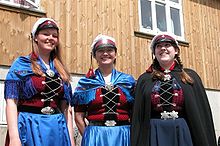Faroese costume

The Faroese folk costume , which, like in other European countries, has its origins in the daily clothing of the people of the 19th century , is widespread in the Faroe Islands and is enjoying new popularity even today, especially among young people.
The folk costume is worn on festive occasions such as B. at weddings and national holidays , such as Ólavsøka . In addition to the usual folk costume, there is also finer festive clothing. That of the women is called Stakkur , the costume of the man Sjóstúka, with the corresponding headgear Stavnhetta.
Stakkur
The Stakkur was worn as festive clothing, especially as a wedding dress , over the course of several centuries and is described as early as 1673 . In the old days it was only the richest peasant women who could afford to wear the stakkur. It was passed on from one generation to the next so that the girls in a family could wear it as a wedding dress. The stakkur consists of a long dress sewn from azure, scarlet or grass green fabric. On rare occasions, the dress was made of black fabric. Today silk is mostly used . The skirt has many folds, the waist is sewn in a princess cut. The sleeves are long and tight and have cuffs that are trimmed with pleated tips. The chest trim and the cuffs are of a different color than the dress, for example red. The stakkur includes a silk collar. a silver belt or a velvet belt set with silver plates. One end of the belt can be decorated with silver, called sproti , which hangs loosely on the skirt. The associated jewelry consists of silver eyelets, cord strands and a large square, often gold-plated brooch with loosely hanging leaves, the stakkanál , which is attached to the scarf on the chest. As a headdress, the woman often wears a crown or a diadem . The Stakkur, seldom seen for a few years, is now experiencing growing interest.
Sjóstúka
The sjóstúka is a knee-length, black loden coat that originally came from the everyday clothes of men 150–200 years ago. In the middle of the 19th century , the sjóstúka became the man's festive clothing. The coat is sewn with side gussets, has a whole back part, the sleeves are wide at the top and rounded at the bottom with a short slit and a button. The doublet has black glass buttons, except for the two upper buttons, which are made of silver and connected with a chain. The sjóstúka is usually worn with white stockings and leather shoes with a silver clasp.
Stavnhetta
The headgear , stavnhetta, was a hallmark of rank and, together with the sjóstúka, was part of the festive clothing of the rich peasants and other high-ranking people.
The sjóstúka and stavnhetta have enjoyed renewed popularity over the past few years, but this costume is still rare.
Web links
- Faroestamps.fo (English, German, Danish, Faroese - Text associated with the stamps shown, public domain basis for this article)
- Source: Life Magazin b / w photo from 1949